The Tudors and the trafficking of enslaved Africans
Sir John Hawkins embarks on the first of four voyages between 1562 and 1569 transporting a total of 1,200 violently captured and enslaved Africans from West Africa to Spanish plantations in the Americas, where they are sold for pearls, hides and sugar. So lucrative were these voyages that Queen Elizabeth I sponsored subsequent journeys, providing Hawkins with ships, supplies and guns. Hawkins only ceased his voyages after he lost the majority of his ships to a Spanish attack off the coast of Mexico in 1568.
To learn more visit slavevoyages.org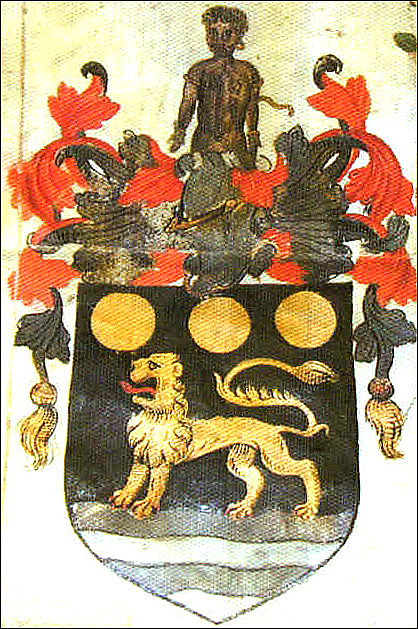
Coat of arms including a bound African granted to John Hawkins in 1565, via Wikimedia Commons, Public Domain.
England establishes a colony in Barbados, its first in the Caribbean
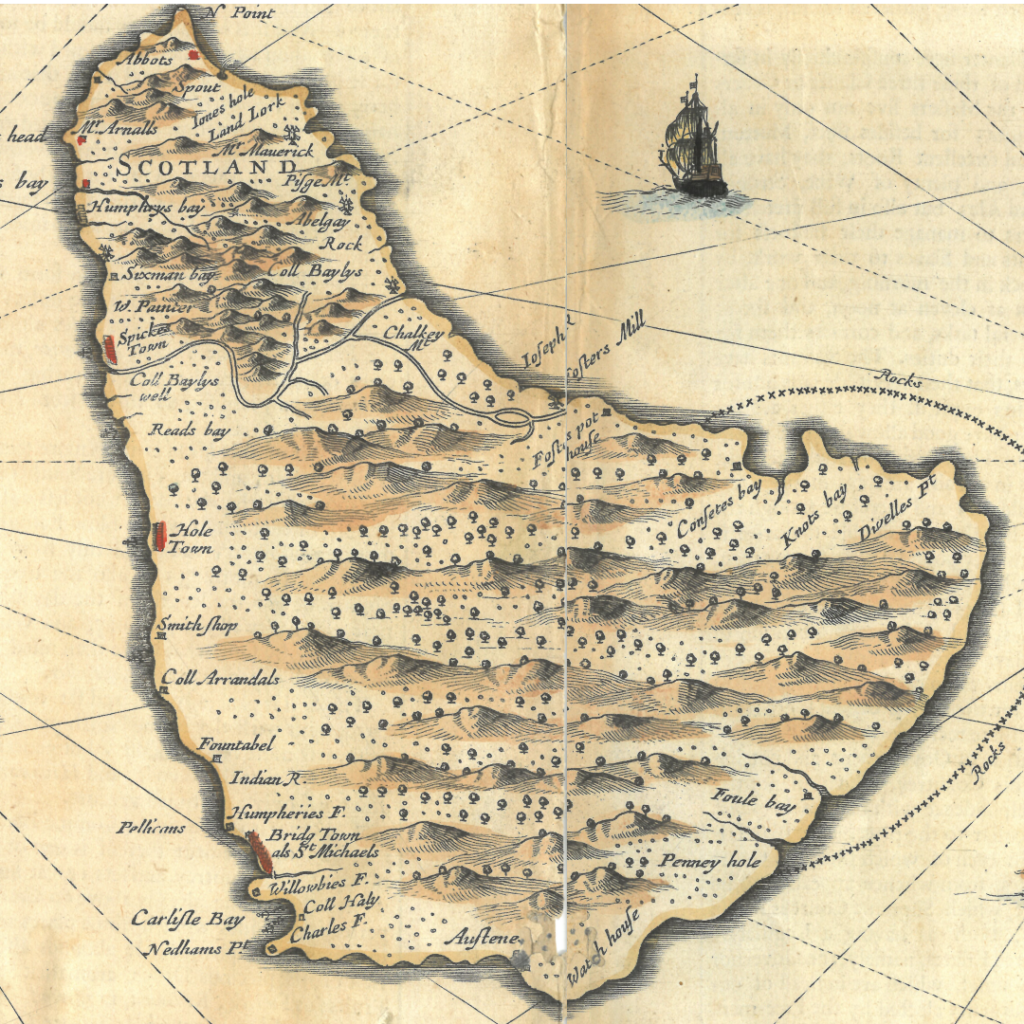
Engraved by Francis Lamb. From An Epitome of M J Speed’s Theatre of the Empire of Great Britain, and of his Prospect of the most famous parts of the world, published by Thomas Bassett and Richard Chiswell, 1676. BCA, Prints/53/2.
The English Protectorate under Oliver Cromwell seizes control of Jamaica during its war with Spain
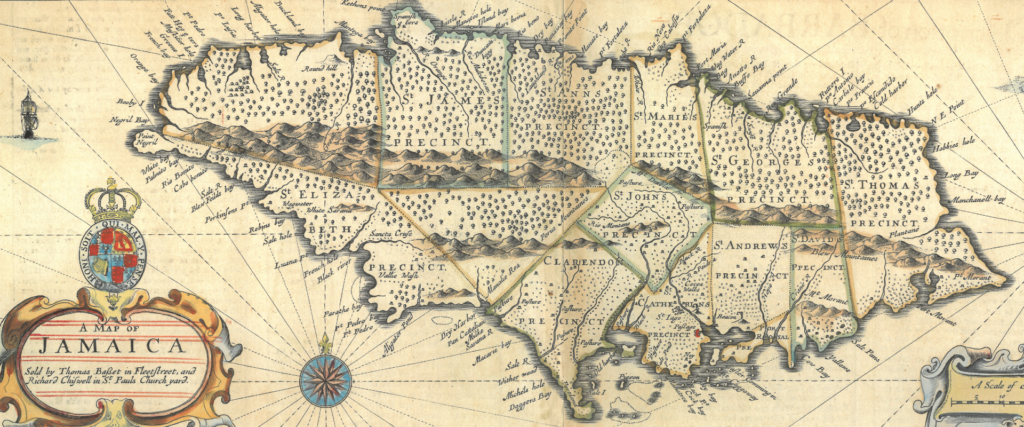
Engraved by Francis Lamb. From An Epitome of M J Speed’s Theatre of the Empire of Great Britain, and of his Prospect of the most famous parts of the world, published by Thomas Bassett and Richard Chiswell, 1676. BCA, Prints/53/2.
The Company of Royal Adventurers Trading into Africa
Charles II grants the Company of Royal Adventurers Trading into Africa a monopoly over “the buying and selling, bartering and exchanging of, for, and with any negro slaves, goods, wares and merchandizes whatsoever to be vended or found” in West Africa. Overseen by James Stuart, Duke of York, the king’s brother, the company’s initial backers include the king and queen, three dukes, seven earls, six lords and many City of London merchants.
The Royal African Company
The Royal African Company is established, the Company of Royal Adventurers having collapsed under its debts. It too is governed by James Stuart, Duke of York. Its charter included the right to establish forts, maintain troops, and exercise martial law in West Africa.
Historian William Pettigrew writes that the Royal African Company “shipped more enslaved African women, men and children to the Americas than any other single institution during the entire period of the transatlantic slave trade. From its foundation in 1672 to the early 1720s, the African Company transported close to 150,000 enslaved Africans, mostly to the British Caribbean.”
The First Maroon War in Jamaica
Self-liberated Africans and native populations on the island of Jamaica launch a guerilla war against British colonists in what became known as the First Maroon War. By 1738 the colonial government, realising it could not defeat the Maroons, was forced to offer the various groups treaties accepting their control of some settlements and territory. In return the Maroons agreed to assist British settlers in recapturing any enslaved Africans who escaped their plantations and attempted to join them.
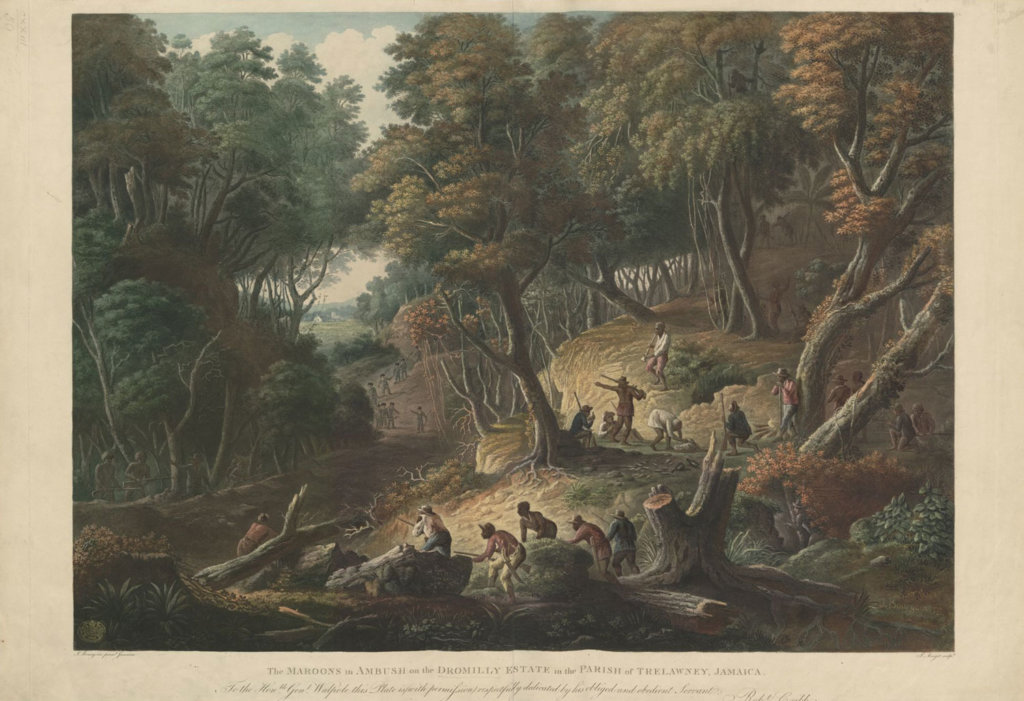
The Maroons in Ambush on the Dromilly Estate in the Parish of Trelawny, Jamaica, by François Jules Bourgoin, J Mérigot, and published by Robert Cribb in London, 1801. Courtesy of the British Library, Public Domain.
The Antiguan Gunpowder Plot
An elaborate plot led by Prince Klass, or Kwaku Takyi, to overthrow white rule in Antigua is allegedly conceived, culminating in a plan to smuggle in gunpowder to blow up much of the island’s elite while at a ball in St. John’s. Details of the plot emerge as suspected participants are arrested, interrogated and, in some cases, tortured, resulting the following year in the trial and execution of 88 enslaved Antiguans. Among them was Prince Klass, who, if the plot was real, was to have been the ruler of the new African-ruled kingdom.
Liverpool and the Slave Trade
A new Customs House is completed in Liverpool, adorned with African heads among its statuary. By the 1740s Liverpool overtook London and Bristol to become the British city most engaged in the trafficking of enslaved Africans. By 1795 over half of all Europe’s slave ships sailed from Liverpool and, to this day, there are streets in the city named after prominent figures involved in the trade, including former mayors.

Detail from a plan of Liverpool in 1725, including its Custom House adjacent to the docks, produced by the surveyor James Chadwick, Wikimedia Commons, Public Domain.
The abolitionist Olaudah Equiano is born around this date in Eboe province in the Kingdom of Benin, in what is now southern Nigeria. Equiano describes his childhood home, upbringing, and the local culture and economy in his autobiography.
Micah Abnah reads from Olaudah Equiano’s The Interesting Narrative of the Life of Olaudah Equiano.

Bust from Benin State, replicating the style of the original bronze cast collections. BCA/71, photographed by Nompumelelo Ncube (Nom), 5th April 2024.
Tacky’s War
Tacky’s War of liberation begins in Jamaica. This was, until the Haitian Revolution of 1790, the largest and most significant uprising of enslaved Africans in the 18th century. Well-led by Africans experienced in warfare, some fifteen hundred men and women laid booby traps, mounted ambushes and skirmished with the militia for 18 months. Over 500 Africans were killed in battle, committed suicide or were executed after Tacky’s forces were eventually defeated, with a further 500 forcibly removed to Nova Scotia.
'Slave Revolt in Jamaica, 1760-61' project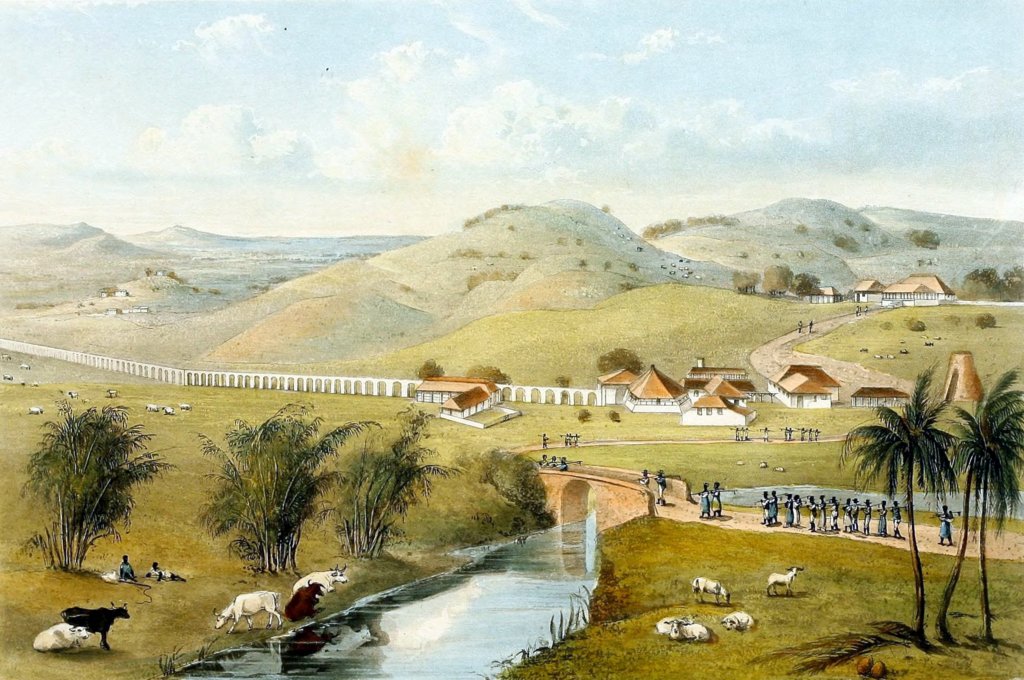
Trinity Estate, St Mary’s, Jamaica, from James Hakewill, A Picturesque Tour of the Island of Jamaica, 1875. Wikimedia Commons, Public Domain.
George Wallace’s Principles
The Scottish advocate George Wallace argues in A System of the Principles of the Laws of Scotland that “every one of those unfortunate men, who are pretended to be slaves, has a right to be declared free, for he never lost his liberty … This right he carries about with him and is entitled everywhere to get it declared. As soon therefore as he comes into a country in which the judges are not forgetful of their own humanity, it is their duty to remember that he is a man and to declare him to be free.”
"As soon as a man sets foot on English ground he is free"
In the case Shanley v. Harvey, the judge, Lord Chancellor Hardwicke, rules, “As soon as a man sets foot on English ground he is free: a Negro may maintain an action against his master for ill-usage and may have a habeas corpus if restrained of his liberty.” However, the legal status of the formerly enslaved in Britain would remain a contested point for decades to come.
The Treaty of Paris, ending the Seven Years’ War between the European great powers, sees Grenada, Dominica, St. Vincent and Tobago transferred to British control.
Treasure Houses of England
Harewood House in Yorkshire is completed. One of the ‘treasure houses’ of England, Harewood was built using a fortune amassed by Henry Lascelles, a banker and sugar importer who held shares in 21 ships involved in the trafficking of enslaved Africans to Barbados.
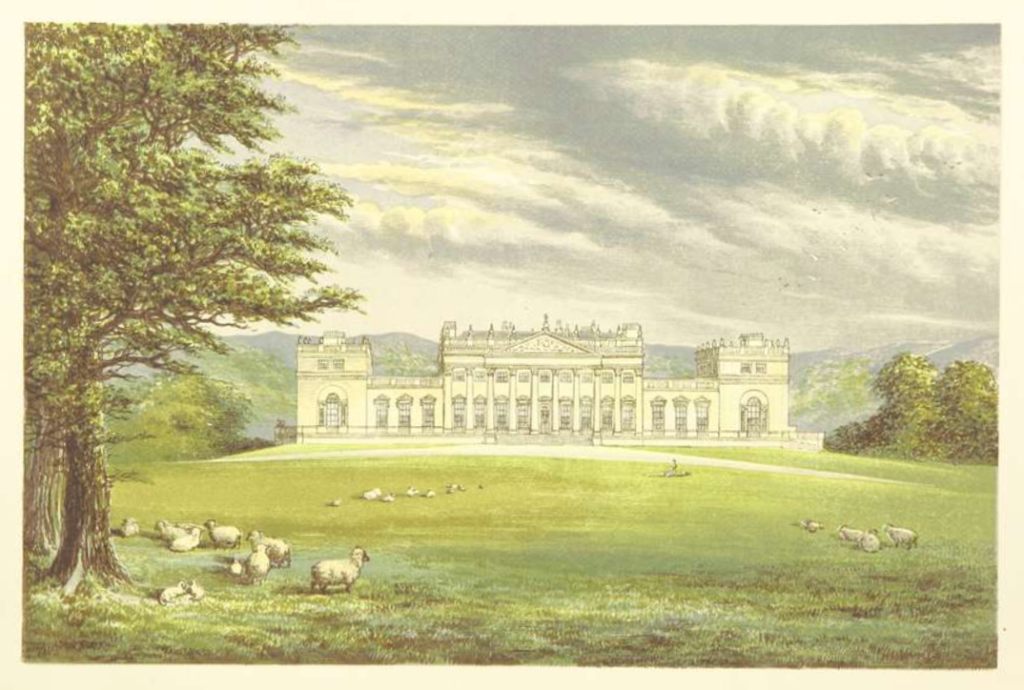
Harewood House, Yorkshire, 1868, courtesy of the British Library. Public Domain.
The Somerset Case
Deciding in favour of the runaway James Somerset, Lord Mansfield rules that enslaved people cannot be detained in England and then deported for sale. “The claim of slavery”, Mansfield states, “never can be supported, the power claimed never was in use here, or acknowledged by the law.” Following the ruling, nearly 200 Africans celebrated with a ball at a public house in Westminster. Mansfield made his historic judgement reluctantly, warning that “the setting of 14,000 or 15,000 men at once loose by a solemn opinion is very disagreeable in the effects it threatens”. In the case of Charlotte Howe in 1785 Mansfield upheld her legal status as enslaved, explaining that his earlier judgement went “no further than that the master cannot by force compel the slave to go out of the kingdom.”
A Narrative of the Remarkable Particulars
A Narrative of the Remarkable Particulars in the Life of James Albert Ukasaw Gronniosaw, An African Prince, As Related by Himself is published.
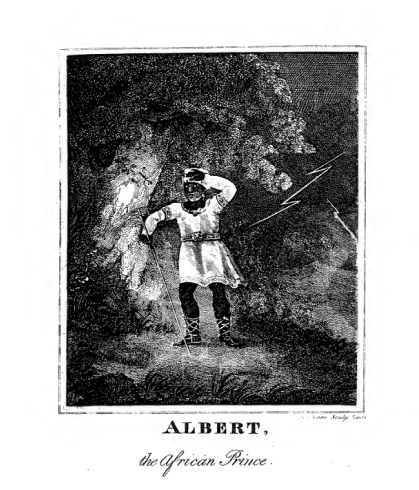
Frontispiece from A Narrative of the Remarkable Particulars in the Life of James Albert Ukasaw Gronniosaw, An African Prince, Related by Himself (1772), via Wikimedia Commons and Emory University Digital Library Publications Program, Public Domain.
Poems on Various Subjects, Religious and Moral
Phillis Wheatley, “To the Right Honourable William, Earl of Dartmouth, His Majesty’s Principal Secretary of State for North America &c.” (c.1772)
Phillis Wheatley’s Poems on Various Subjects, Religious and Moral is published in London, the first book of verse to be published by an African-American woman.
While in London for the publication of her poems, Phillis met many prominent reformers and public dignitaries, including Benjamin Franklin, later one of the Founding Fathers of the United States of America.
Phillis’s poetry also included public and political matters, including the poem you can hear above written in 1772 for the earl of Dartmouth in thanks for his role in ending the unpopular Townshend Acts. In this poem, Phillis describes her own enslavement and appeal for others to be spared this fate. A few years earlier, Phillis had also written a verse condemning a British soldier for the murder of Boston teenager while the town was occupied by the British army.
Phillis had been enslaved as a young girl and taken to Boston, where she was held as the property of John and Susanna Wheatley, who had encouraged her gift for writing. On her return to Boston later in 1773 her freedom was restored.

Phillis Wheatley, Poems on Various Subjects, Religious and Moral, 1773, courtesy of the British Library, Public Domain.
Uprising at Gannimarew
In the same year, the Edinburgh Evening Courant includes an extract of a letter dated 12 April from Fort James, River Gambia, telling of an uprising of enslaved people on the New Britannia at ‘Gannimarew’ on 24 January.
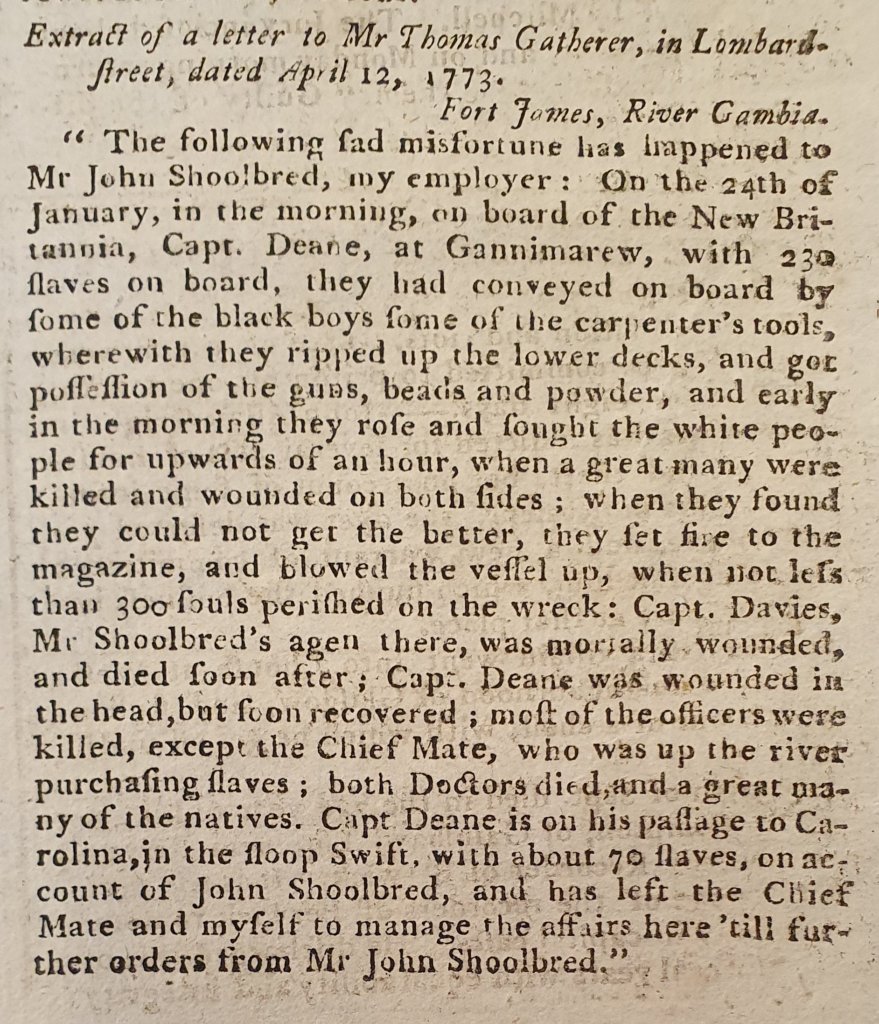
Edinburgh Evening Courant, 16 October 1773. BCA, Antique Newspapers, AN/7.
Powering the Industrial Revolution
The first James Watt steam engines are installed, representing a technical innovation that would profoundly accelerate Britain’s industrial revolution. While Watt later condemned slavery, according to the historian Eric Williams, it was profits from the West Indian trade that financed the inventor and the development of his steam engine.
The Zong
More than 130 enslaved Africans are murdered by the crew of the British slave ship Zong when it began to run low on drinking water after navigational errors. The massacre comes to light after the ship’s insurers refuse the claim made by its owners against the loss and the matter goes to trial. The abolitionist Granville Sharp, being alerted to the massacre by Olaudah Equiano, unsuccessfully sought to have the ship’s crew prosecuted for murder.

Throwing overboard the Dead and Dying – Typhon Coming On by J. M. W. Turner, 1840, via Wikimedia Commons, Public Domain.
The Letters of the Late Ignatius Sancho
Ignatius Sancho’s Minuets Cotillons and Country Dances 1-3, performed by Peter Moutoussis, Alexander Boukikov, Wiebke Thormaehlen, Taisia Sandetcaia and Joseph Crouch, 2021, via Sound Heritage from the University of Southampton.
The Letters of the Late Ignatius Sancho, an African are posthumously published. Playwright, theatre and art critic, and composer, Sancho was the first documented African voter in a British general election. The first edition of his Letters had over 1,200 subscribers, raising £500 for his widow and family.
Rio Attoh-Wood reads from Ignatius Sancho’s Letters of the Late Ignatius Sancho, an African.
Sancho, who had been born on a slave ship enroute to the West Indies, became an important figure in the abolitionist movement. In 1766 he famously wrote to the popular novelist Laurence Sterne, convincing him to speak out against slavery, and, through his own writings, expressed the instability and uprooted existence of those who had been enslaved.

Ignatius Sancho by Thomas Gainsborough, 1768, via Wikimedia Commons, Public Domain.
"The Evil and Wicked Traffic"
Quobna Ottobah Cugoano’s Thoughts and Sentiments on the Evil and Wicked Traffic of the Slavery and Commerce of the Human Species is published. Cugoana declares that the enslaved have a moral duty to resist.
Emmanuel Akinkoulie reads from Quobna Cugoano’s Thoughts and Sentiments.
The Society for the Abolition of the Slave Trade is founded
The London Committee for Effecting the Abolition of the Slave Trade is formed. Among its original twelve members were Thomas Clarkson and Granville Sharp. Nine were Quakers. Through figures like William Wilberforce, the committee introduced several abolition bills in Parliament.
Recognising that they needed to mobilise public opinion, abolitionists gave public lectures and printed pamphlets that sought to draw attention to the reality and inhumanity of slavery, often drawing upon the first-hand accounts of formerly enslaved Africans.
It was not long after Clarkson spoke in Manchester that the town sent a petition containing over 11,000 signatures to Parliament calling for an end to slavery. That equated to approximately 20% of its population, many of whose livelihood was dependent on a booming textile industry that consumed cotton produced by enslaved Africans in the southern United States.

‘Am I not a man and a brother?’, William Hackwood or Henry Webber, the factory of Josiah Wedgewood and Sons, 1787. Medallions featuring this motif could be mounted and worn to signify the wearer’s dedication to the cause of abolition. RCIN 45792, courtesy of the Royal Collection Trust / © His Majesty King Charles III 2024.
The Sons of Africa
The Sons of Africa, a Black lobby group, publishes a letter in The Diary expressing gratitude that ‘the nation at large is awakened’ to the suffering of Africans. This group, thought to be the first Black political organisation in British history, petitioned parliament, wrote letters to newspapers, and organised lectures.
Led by Olaudah Equiano and Ottobah Cugoano, members included Jasper Goree, George Robert Mandeville, James Bailey, William Stevens, Joseph Almaze, Boughwa Gegansmel, Cojoh Ammere, and several others.
The MP Sir William Dolben, after corresponding with the Sons of Africa and seeing a slave ship being fitted out for a voyage, proposed a parliamentary bill to improve the conditions on slave ships. From this, the Slave Act 1788 was the first law passed to regulate the slave trade and established rules for how many enslaved Africans could be carried on a ship in relation to its size.
The Interesting Narrative of the Life of Olaudah Equiano
The Interesting Narrative of the Life of Olaudah Equiano is published. An anti-slavery activist and lobbyist in Britain, Equiano is popularly held to be the country’s first Black political leader. His Interesting Narrative went through nine editions in five years, and Equiano is recorded as giving lectures in Manchester, Nottingham, Sheffield, Cambridge and Durham.
Micah Abnah reads from Olaudah Equiano’s The Interesting Narrative of the Life of Olaudah Equiano. To learn more about Olaudah Equiano, you can visit our online exhibition produced with Google Arts and Culture.
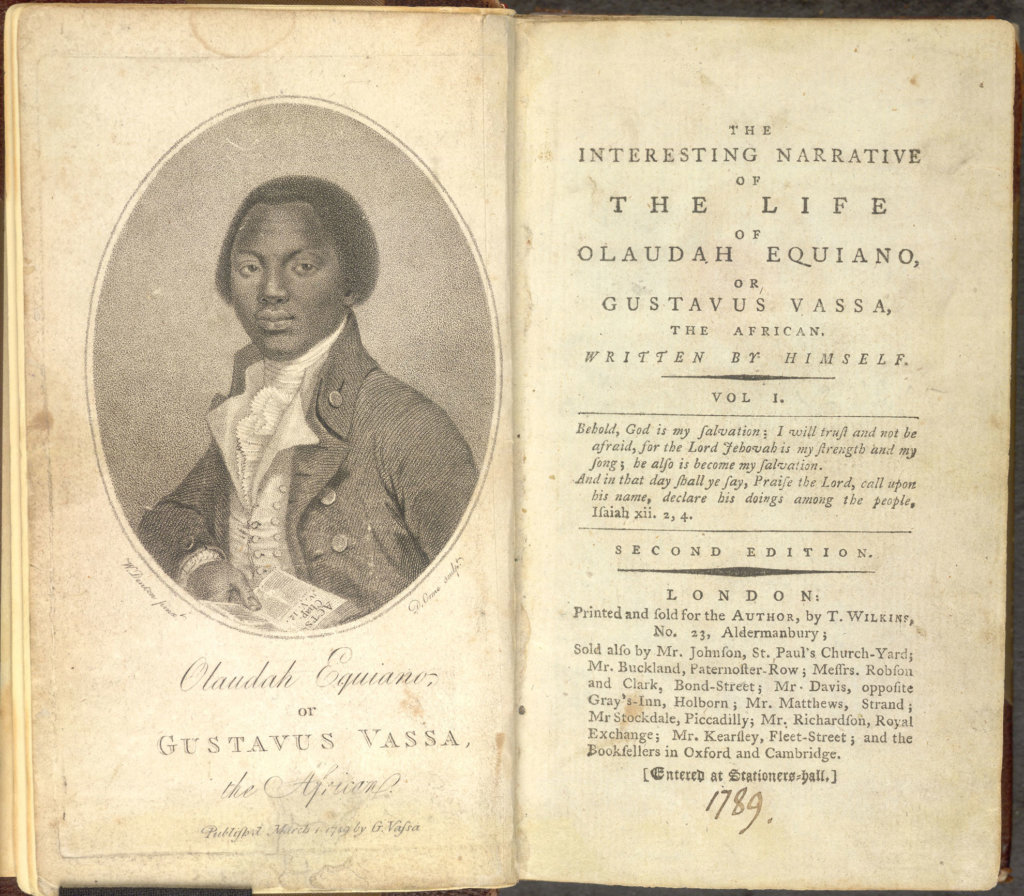
Olaudah Equiano was one of the co-founders of the Sons of Africa. Image courtesy of the British Library. Public Domain.
The Haitian Revolution
The Haitian Revolution, an uprising of self-liberated formerly enslaved Africans against French colonial rule, begins on 22 August. The revolution ended in 1804 and resulted in the founding of a new state, independent, ruled by non-whites, and free from slavery.

Toussaint Louverture on Horseback, 1802, via The Met, Public Domain.
Nearly 2,000 self-liberated Africans who had fought with the British during the American War of Independence arrive in Freetown, Sierra Leone, to start a new life.
The Second Maroon War
The Second Maroon War begins in Jamaica after two members of the community were flogged. An eight month guerilla war ensued.
In the same year, inspired by the French and Haitian Revolutions, Julien Fédon, a mixed race owner of the Belvedere estate on Grenada, launches a rebellion against British rule. As many as 14,000 enslaved Africans joined the uprising seeking emancipation. Fédon’s forces were defeated by the British the following year.
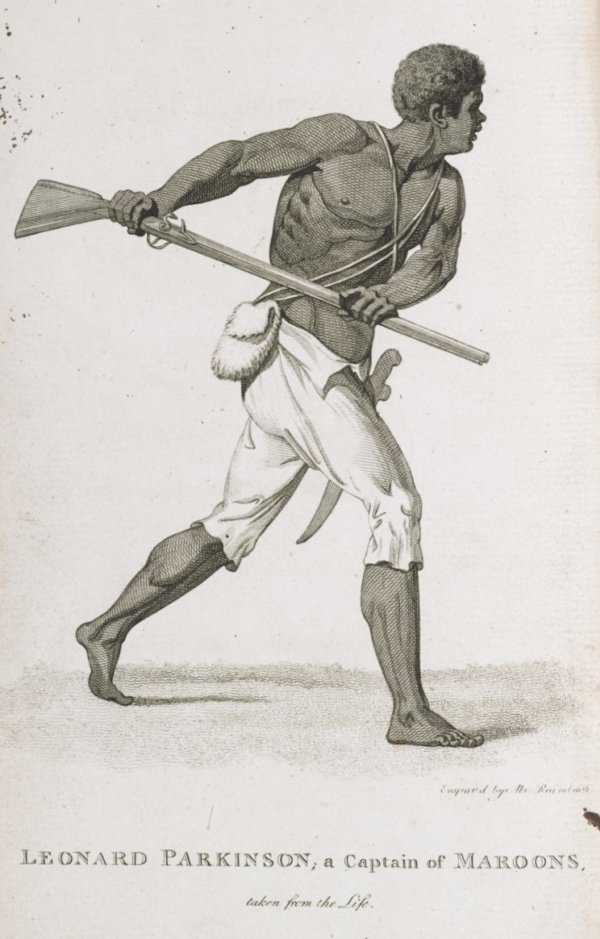
Leonard Parkinson, A Captain of the Maroons; taken from the Life, 1786, via the British Library, Public Domain.
The trafficking of enslaved Africans is abolished
The trafficking of enslaved Africans, in British registered vessels, is abolished by Parliament on 25th March 1807. The Act for the Abolition of the Slave Trade was the culmination of one of the first and most successful public political campaigns in UK history. In the West Indies, however, conditions for the enslaved worsened as plantation owners increased the demands of their enslaved workforce.
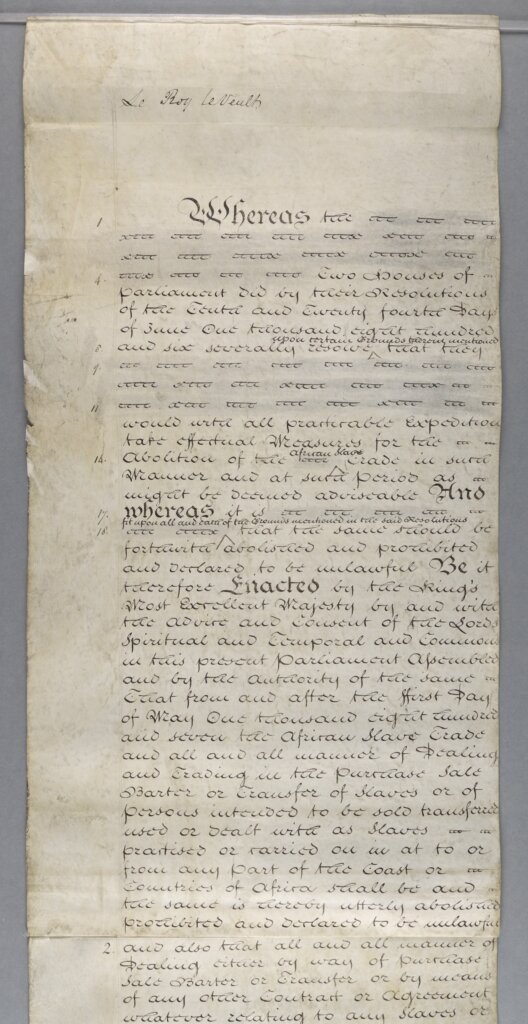
An Act for the Abolition of the Slave Trade, 1807. Parliamentary Archives, HL/PO/PU/1/1807/47G3s1n60.
Bussa's Rebellion in Barbados
Some 400 enslaved men and women, led by a ranger called Bussa, and including men of the all-Black West Indian Regiment, revolt against the ruling elite on Barbados. 50 enslaved people died in the three day uprising, with 70 more summarily executed in the field. Another 300 were taken to Bridgetown for trial, of which 144 were executed and 132 transported to another island.

Sketch of a flag taken from the enslaved at Barbados,1816, MFQ 1/112 (2), courtesy of The National Archives, Public Domain.
Uprising in Demerara-Essequibo
Approximately 13,000 enslaved Africans rise up against plantation owners in Demerara-Essequibo (roughly corresponding to modern-day Guyana). Spurred by false rumours of imminent emancipation, the rising was led by enslaved people including the deacon and carpenter Quamina (aka Quamina Gladstone) and his son, Jack Gladstone.
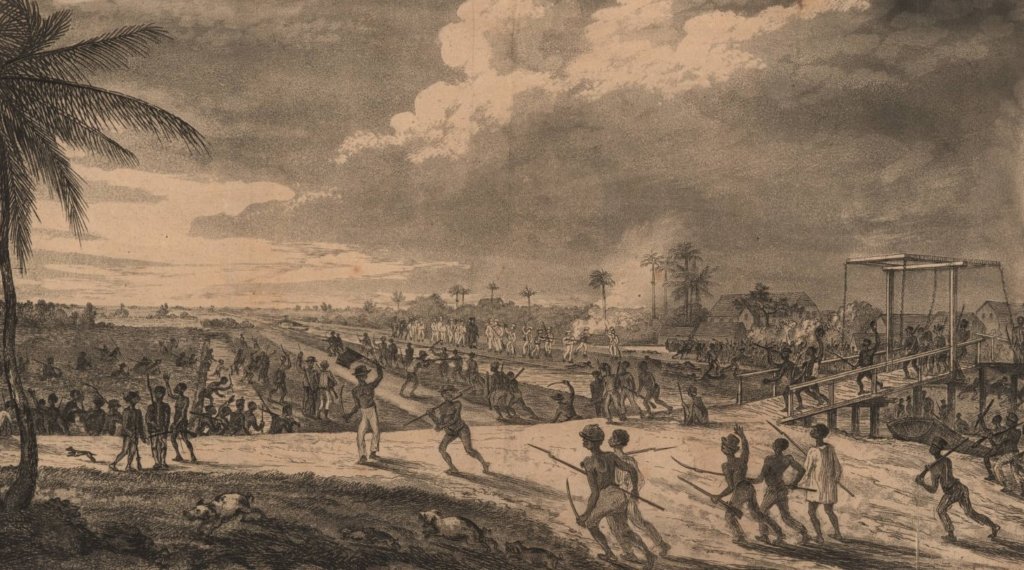
The retreat of Lieutenant Brady, via Wikimedia Commons, Public Domain.
The Anti-Slavery Society
The Society for Mitigating and Gradually Abolishing the State of Slavery throughout the British Dominions, also known as the Anti-Slavery Society, is formed by William Wilberforce, Thomas Clarkson, Thomas Fowell Buxton and others.
The Horrors of Slavery
The Horrors of Slavery by Black working class radical preacher Robert Wedderburn is published. Wedderburn, the son of a Scottish plantation owner and an enslaved African named Rosanna, was a Spencean. The Spenceans called for religious toleration and a redistribution of private property. In two issues of Wedderburn’s periodical, The Axe Laid to the Root, Wedderburn had laid out an equally radical vision for a post-revolution West Indies, including universal suffrage; annual elections, excluding Whites and those worth more than £500; equal land distribution; the abolishment of prisons and capital punishment; and a ban on lawyers and clergymen.

Frontispiece of Robert Wedderburn’s The Horrors of Slavery (London 1824), via archive.org, Public Domain.
The Birmingham and West Bromwich Ladies Society for the Relief of Negro Slaves is established
Established by Lucy Townsend, founding members include Mary Lloyd, Elizabeth Heyrick, Sophia Sturge and Sarah Wedgwood. Around the country, several auxiliary societies were set up by and for women, and affiliated to the Anti-Slavery Society.
'An Appeal to the Hearts and Conscience of British Women'
The abolitionist Elizabeth Heyrick publishes her influential pamphlet, ‘An Appeal to the Hearts and Conscience of British Women’, in which she calls for a boycott of West Indian sugar and other goods produced using the labour of enslaved Africans.
Sarah Whitehouse reads Elizabeth Heyrick’s pamphlet No British Slavery (1830).
The History of Mary Prince
The History of Mary Prince, a West Indian Slave, related by herself, the first account of the life of an enslaved Black woman, is published in Britain. Prince was born in Bermuda circa 1788.
Natasha Bain reads from The History of Mary Prince.
In the same edition, the Narrative of Louis Asa-Asa, a Captured African is also published. In this account, Asa-Asa describes his upbringing, the raids conducted by slave traders, and ends with an appeal to the king to end slavery.

Front page of The History of Mary Prince, A West Indian Slave, 1831, via Wikimedia Commons, Public Domain.
The Great Jamaican Slave Revolt
The Great Jamaican Slave Revolt begins, led by the Black Baptist deacon Samuel Sharpe. What started as a peaceful labour strike quickly became a full-blown revolt involving tens of thousands and five weeks of plantation burning and reprisal summary executions. Though suppressed, the brutality of the colonial rulers helped galvanise British public opinion against slavery.

The burning of Roehampton Estate January 1832, Adolphe Duperly, 1833, via Wikimedia Commons, Public Domain.
The Great Reform Act
The Representation of the People Act 1832, also known as the first Reform Act or Great Reform Act, is passed. This broke the power of the West Indian faction in Parliament, which had exploited ‘rotten’ and ‘pocket’ boroughs to buy themselves approximately fifty seats in the unreformed House of Commons.
The Abolition of Slavery
The Abolition of Slavery Act is passed, to come into effect in 1834. Enslavement was replaced initially with an apprenticeship system that was to continue to bind the formerly enslaved to their plantations until 1840. Plantation owners were awarded between £15-20 million in compensation. No compensation was offered to the formerly enslaved.
Enslaved people in Bermuda and Antigua freed
On 1st August, only Bermuda and Antigua freed all enslaved people immediately. In the other colonies, children under the age of 6 were immediately free, while everyone else had to provide up to 45 hours a week of unpaid labour for their former masters. Widespread abuses by estate owners led to the early termination of the apprenticeship system in 1838.
The abolition of slavery is announced in Jamaica
Sir Lionel Smith, Governor of Jamaica, takes to the steps of King's House, Spanish Town, to read the proclamation abolishing slavery in Jamaica and other British territories.
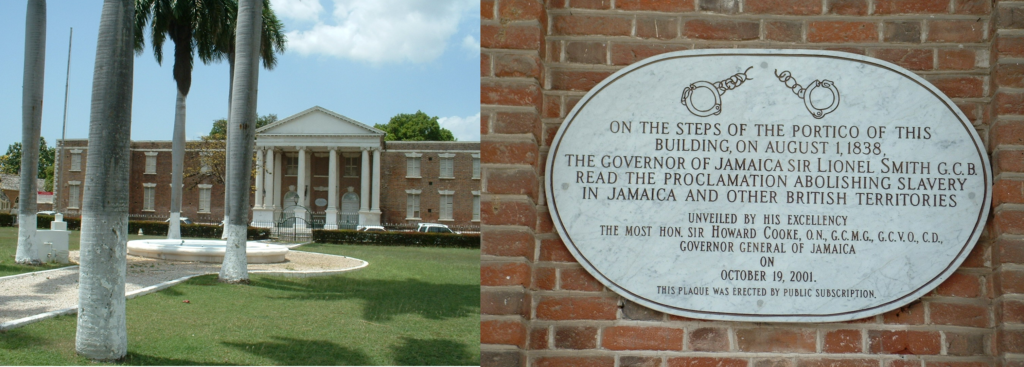
King’s House, Governor’s Residence, Spanish Town, Jamaica. Photographed 2003, Ayshah Johnston.
Frederick Douglass
The celebrated abolitionist Frederick Douglass begins a two year lecture tour of Britain. Douglass was one of many African American abolitionists who toured Britain seeking to raise funds and support for the abolitionist cause in the United States.

Frederick Douglass, 1856, National Portrait Gallery, Smithsonian Institution, NPG.74.75, CC0
Sarah Parker Remond
The abolitionist Sarah Parker Remond arrives in Britain and begins a lecture tour. Later, Parker Remond would attend Bedford College, the first higher education college established for women, and would sign the first mass petition to Parliament calling for women’s suffrage.
Natasha Bain reads from ‘Miss Remond in Manchester’, The Anti-Slavery Advocate 34.2 (1 October 1859).

Sarah Parker Remond, via Wikimedia Commons, Public Domain.
The US abolishes slavery
The American Civil War ends and the Thirteenth Amendment to the US constitution, abolishing slavery, is passed.
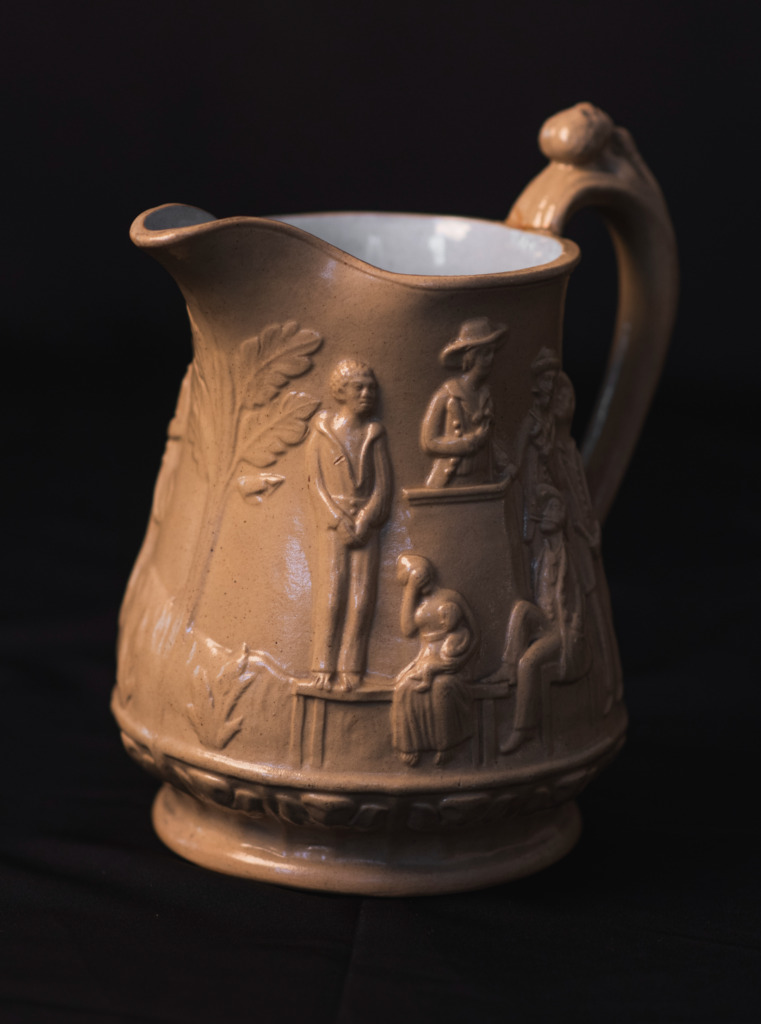
Abolitionist pitcher, housed at Black Cultural Archives, photographed by Nompumelelo Ncube (Nom), 5 April 2024, BCA 202. The abolitionist campaigns generated a broad and rich body of what we might today call merchandise, objects which could be bought and displayed, used or worn to demonstrate the owner’s support for the cause.
Slavery is abolished in Cuba
Slavery is abolished in Brazil
Queen Mother Moore is born
Born Audley Moore, Queen Mother Moore, was a Black woman born in Louisiana, US in 1898. She became an activist leader in the age of Marcus Garvey’s Universal Negro Improvement Association (UNIA). She joined the call from Garvey and others for Reparations for enslavement and colonialism in the form of land, money, and a reversal of the historic, and continuing, denigration of African cultural expressions in the US.
In 1957, Moore presented a petition to the United Nations, and a second in 1959, arguing for self-determination, against genocide, for land and 200 billion dollars in Reparations for 400 years of slavery.
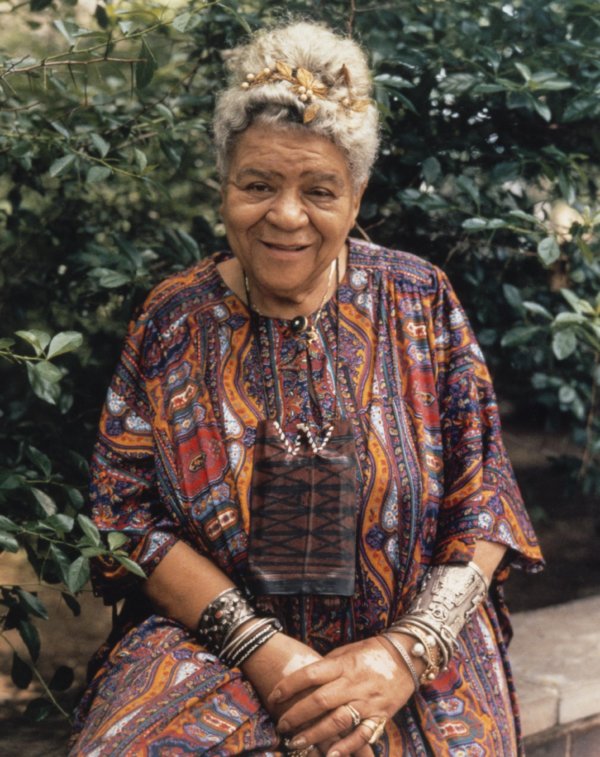
Audley ‘Queen Mother’ Moore, Schlesinger Library, Public Domain.
The former slave colonies remained under British control until the mid-20th century. Consequently, land and the major industries remained in the hands of a ruling minority, leading to economic under-development and the perpetuating of social inequalities.
The Pan-African Movement, emerging at the end of the 19th century, was dedicated to achieving liberation and united self-governance. Pan-Africans today continue to campaign for compensation, known as Reparations.
Credits
Black Cultural Archives Timelines are brought to you through a collaboration between Black Cultural Archives and Royal Holloway, University of London. Our five-year partnership, launched in 2023, aims to make the teaching and learning of inclusive, shared histories available for everyone. Many of the documents and artifacts presented are from BCA’s unique archival collections, digitised to support access to a broader audience.
Project Team:
Dr. Ayshah Johnston, Learning and Engagement Manager, Black Cultural Archives.
Dr. Matthew Smith, Senior Lecturer in Public Humanities, Royal Holloway, University of London.
Carmen Andall Woodroofe, PhD candidate, Department of Music, Royal Holloway, University of London.
Where next?
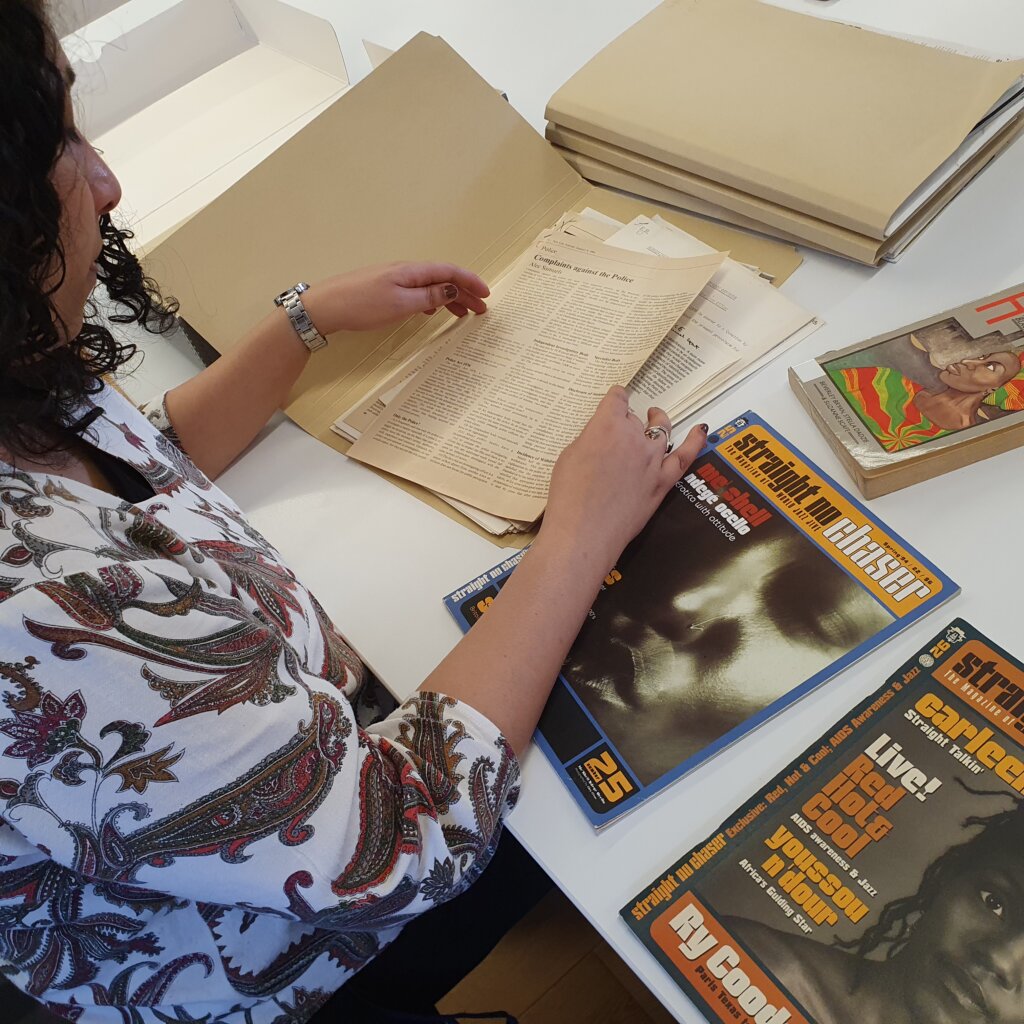
Collections
Search our Subject Guides for information on Enslavement and Reparations. Search the Catalogue for BCA’s archival materials which are available to view in our reading room.
Explore BCA Collections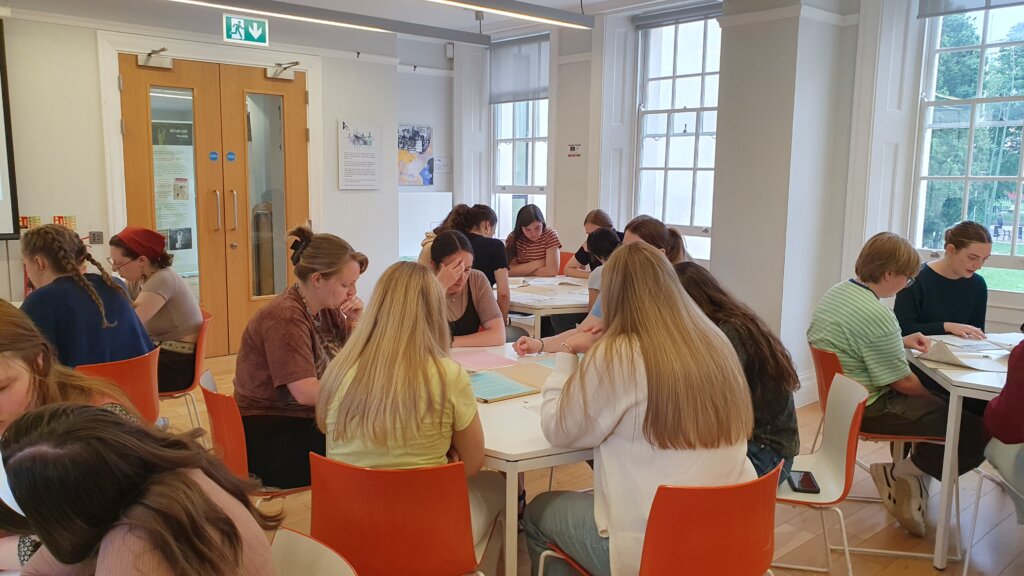
Workshops
Our range of school, higher education and adult workshops includes Black Abolitionists in Georgian London. Bespoke workshops may also be considered.
Book a Workshop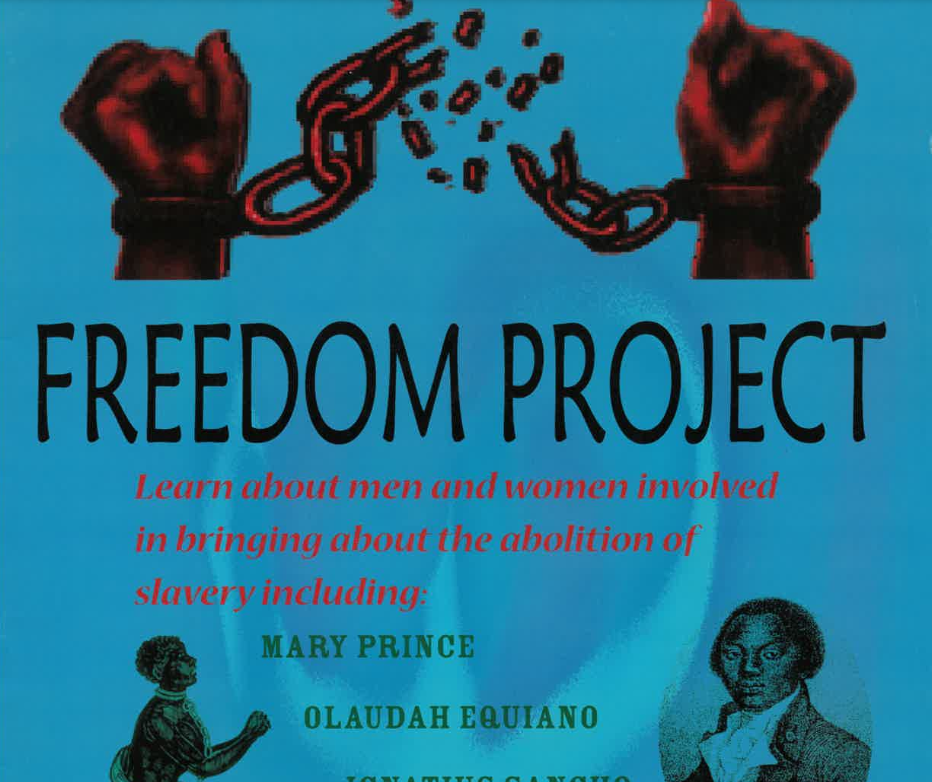
Resources
This section is dedicated to the sharing of teaching resources. If you would like to add a resource, please get in touch with the learning department.
Find Resources